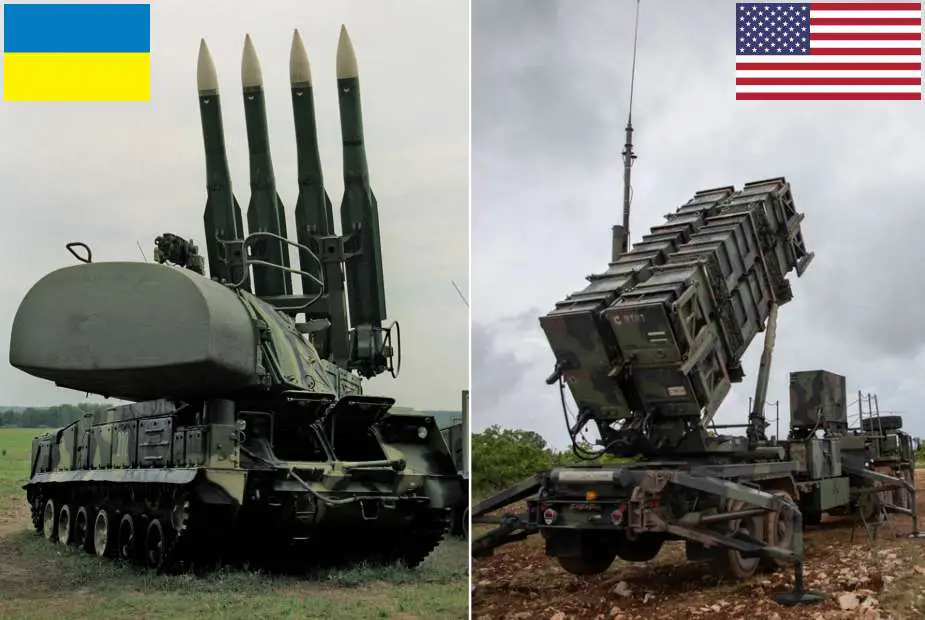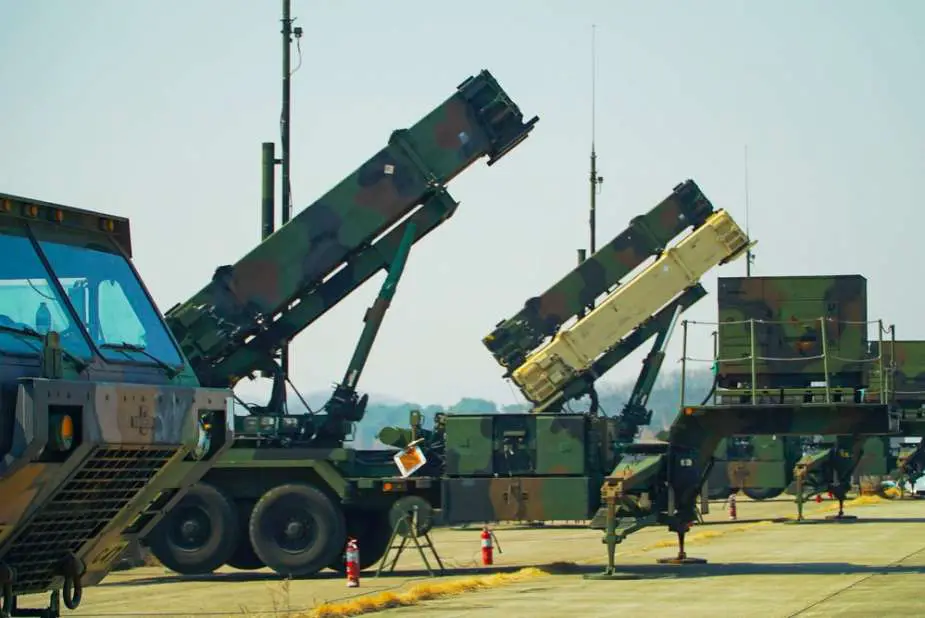As reported by The New York Times on October 28, 2023, Ukraine initiated an unconventional program known as the FrankenSAM initiative to enhance its air defense capabilities. The FrankenSAM program represents an innovative approach that combines modern Western surface-to-air missiles with retrofitted Soviet-era launchers and radars already in Ukraine's military inventory.
Follow Army Recognition on Google News at this link

The FrankenSAM project will use components of Russian Buk-M1 and US Patriot air defense systems used by Ukraine. (Picture source: Russian social media and US DoD)
The program's origins can be traced back to late last year when Ukrainian officials sought assistance from their allies to find suitable missiles for approximately 60 Soviet-era Buk launchers and radars that were in Ukraine's possession but not in active use. Given the challenges of acquiring Russian-manufactured munitions compatible with the Buk systems, the Ukrainians proposed an alternative solution: adapting the launchers to accommodate NATO-caliber antiaircraft missiles donated by the United States.
Recognizing the pressing need to enhance air defenses, particularly for the approaching winter season and the potential for Russian exploitation of this situation to target energy infrastructure, Ukrainian officials offered to modify the weapons themselves. However, American engineers insisted on taking on the task. It took over seven months to complete the testing and approval of the hybrid systems after the Pentagon's agreement in January to provide Sea Sparrow missiles for the project.
Originally initiated in Ukraine, this program has garnered support from the US Department of Defense, resulting in the development of three distinct hybrid air defense systems called FrankenSAM. The first system combines Soviet-era Buk launchers with American Sea Sparrow missiles, while the second and third systems integrate Soviet-era radars with American Sidewinder and Patriot missiles. Thorough testing of these combined air defense systems was conducted at military facilities in the United States, with plans to deliver them to Ukraine in the upcoming autumn.
The first system involves retrofitting Soviet-era Buk-M1 systems with American RIM-7 Sea Sparrow missiles to address the shortage of Soviet 9M38 missiles. This hybrid system combines the transporter erector launcher (TELAR) known as 9A310 from the Buk-M1 with Sea Sparrow missiles. Both the 9M38 and RIM-7 missiles rely on semi-active guidance to lock onto targets, allowing them to be used with the 9S35 Fire Dome tracking and illumination radar used in the Buk system. While this FrankenSAM may necessitate the installation of a new radar, there is potential for frequency and modulation compatibility.
Oleksandra Ustinova, a member of the Ukrainian Verkhovna Rada, has provided information regarding the progress of this project. According to her, five launchers have already been converted in the United States, and the first units have already arrived in Ukraine. There are plans for an additional 17 launchers to undergo retrofitting soon, which may be completed before winter concludes. The retrofitting of these launchers with RIM-7 Sea Sparrow missiles appears to be progressing efficiently, as the five units were converted within a month.
The second hybrid air defense system solution is under development in Ukraine, which involves integrating Soviet-era radars with American AIM-9 Sidewinder missiles. This approach is based on the AIM-9M Sidewinder missile's adaptability, requiring only minor modifications for integration, which can simplify target engagement and enhance air defense capabilities. Unlike the RIM-7 Sea Sparrow, the Sidewinder does not require a tracking and illumination radar.
The AIM-9M missile, equipped with an infrared homing head, reduces the operator's role in guiding the missile toward the target, launching the homing head, and initiating the missile's pursuit upon the target lock. In principle, the AIM-9M air defense system shares similarities with the Soviet Strela-10 or the American MIM-72 Chaparral systems, especially when the AIM-9D variant was minimally modified to engage targets at ranges of up to 5 km and altitudes of up to 4 km.
The AIM-9M launcher's chassis presents minimal challenges due to the missile's manageable dimensions, making it compatible with various platforms. Additionally, there are indications that data from the Soviet radar may be integrated into the system, providing real-time information to the operator about the target's type, course, height, and speed. Such an approach has been implemented previously in the United States with systems like the AN/TWQ-1 Avenger, which simplifies the operator's tasks. Another consideration is integrating the AIM-9M into an existing air defense system, such as the 9K33 OSA, where the surveillance radar would primarily focus on target detection.

Patriot missile systems positioned in standby mode during a training exercise in South Korea in 2023. (Picture source: US DoD)
The third FrankenSAM system, which will be the most powerful of the three hybrid systems, represents a notable advancement in Ukraine's air defense capabilities as it combines Patriot missile components with domestically produced radar systems. Currently in the testing phase, it is anticipated that this system will be delivered to Ukraine during the winter season, along with donated Patriot missiles and additional components from various allies.
The initial live firing tests for this third FrankenSAM project have yielded positive results, with the system successfully destroying a target drone. Although specific details are limited, it is reported that this system can deploy Patriot missiles "with Ukraine’s older, domestically made radar systems." The integration of these advanced components is expected to make this SAM system one of the most potent in development. The first operational unit is scheduled to arrive in Ukraine in the upcoming winter, accompanied by donated missiles and other Patriot parts.
Patriot missiles, including the GEM-T for aerodynamic targets and the CRI/MSE for anti-missile interceptors, require radio command guidance in the initial stages of engagement. To achieve this, they rely on radars such as the AN/MPQ-53, AN/MPQ-65, or the newer LTAMDS. In the terminal stage, the CRI and MSE kinetic interceptors utilize their own active radar. The GEM-T, on the other hand, incorporates a radar that operates concurrently with a semi-active mode, transmitting target data to the system's main radar, which then sends commands to the missile.
The integration of Patriot launchers with the Remote Interceptor Guidance-360 (RIG-360) system and Ukrainian radars, such as the 80K6KS1 Phoenix, may offer a viable solution. This approach addresses a significant challenge, as the transfer of complete Patriot systems is logistically complex due to their scarcity. While Western countries have provided various air defense systems to Ukraine over the past 20 months, including Patriot and IRIS-T systems, this latest development, involving Patriot missiles and domestically produced radar systems, holds promise for further enhancing Ukraine's air defense capabilities.
Ukraine has received significant military aid from its allies since Russia's full-scale invasion in February 2022, totaling nearly $100 billion. The United States has been the primary contributor, providing substantial funding for weapons and military equipment. There is ongoing consideration of an additional $60 billion in aid under a new Biden administration emergency spending plan.















